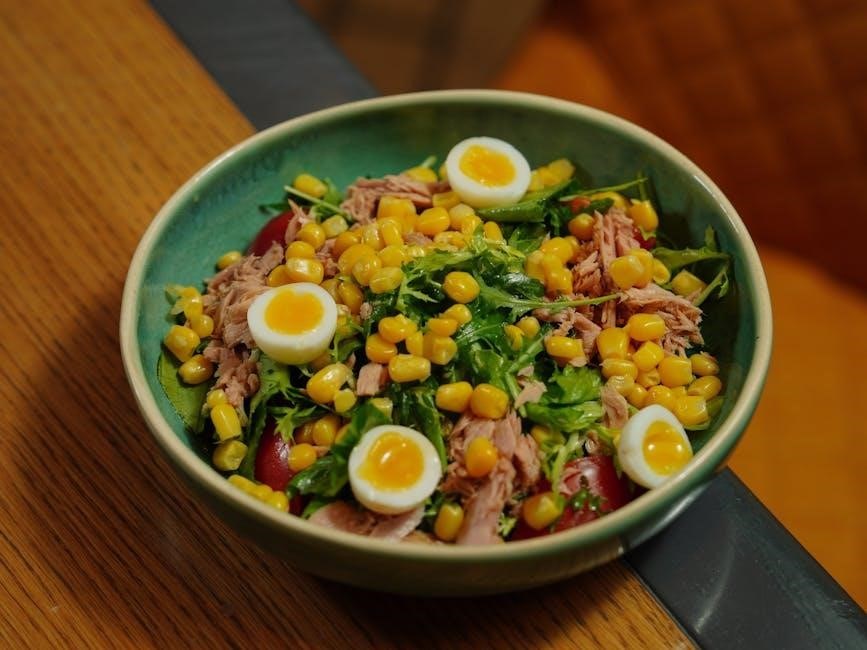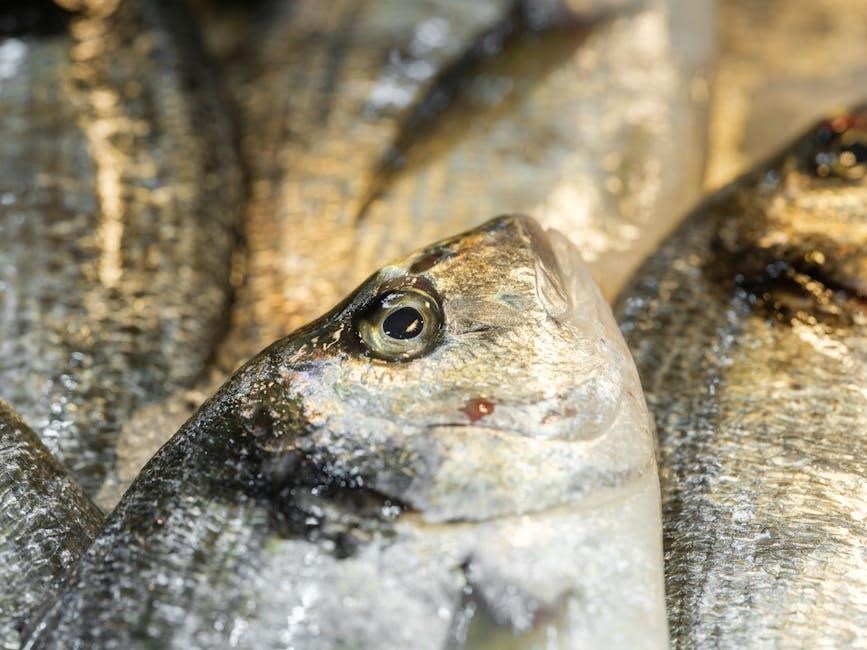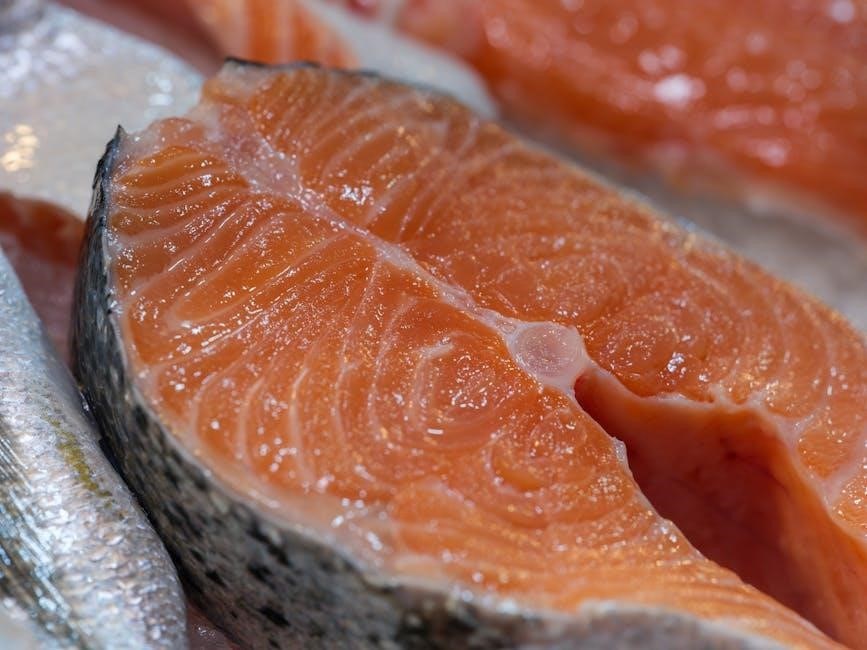A pescatarian diet combines plant-based foods with fish and seafood, offering a balanced approach to nutrition. It’s ideal for those seeking to reduce meat consumption without eliminating protein sources.

1.1 What is a Pescatarian Diet?
A pescatarian diet is a dietary choice that excludes meat but includes fish and seafood. It emphasizes plant-based foods like vegetables, fruits, and whole grains, while incorporating fatty fish such as salmon and mackerel for essential nutrients. This diet is often seen as a middle ground between vegetarian and meat-based diets, providing a balanced approach to nutrition. It focuses on whole, nutrient-rich foods, making it a popular choice for those seeking healthier eating habits without completely eliminating animal products. The pescatarian diet is versatile and can be tailored to suit various lifestyles and preferences.
1.2 Why Choose a Pescatarian Diet?
Choosing a pescatarian diet offers numerous benefits, making it an appealing option for many. It provides a balanced intake of protein from fish and seafood, which are rich in omega-3 fatty acids, essential for heart health and brain function. This diet also promotes a lower risk of chronic diseases compared to meat-heavy diets. Additionally, it supports weight management and can be more environmentally friendly than diets reliant on land animals. Many people opt for this diet as a sustainable and ethical choice, combining health advantages with a reduced environmental footprint. It’s also a flexible option for those transitioning to a more plant-based lifestyle.

Key Components of a Pescatarian Diet
A pescatarian diet emphasizes fish, seafood, plant-based foods, whole grains, legumes, and healthy fats. It excludes meat but includes omega-3 rich fatty fish like salmon and mackerel.
2.1 Fish and Seafood
Fish and seafood are central to a pescatarian diet, providing essential protein and omega-3 fatty acids. Fatty fish like salmon and mackerel are rich in these healthy fats, which support heart health and reduce inflammation. Shellfish, such as shrimp and mussels, offer additional nutrients like vitamin D and selenium. Fish is also a lean protein source, making it ideal for those seeking to maintain muscle mass while avoiding meat. Including a variety of fish and seafood ensures a broad intake of vitamins and minerals, supporting overall health and well-being. Rotate options like tuna, cod, and tilapia to keep meals diverse and nutrient-rich.
2.2 Plant-Based Foods
Plant-based foods form the foundation of a pescatarian diet, providing essential vitamins, minerals, and fiber. Vegetables, fruits, and whole grains are rich in antioxidants and nutrients, supporting immune function and overall health. Legumes, such as lentils and beans, offer protein and fiber, while nuts and seeds provide healthy fats and micronutrients. Incorporating a variety of colorful fruits and vegetables ensures a broad intake of vitamins and minerals. Whole grains like quinoa, brown rice, and oats add complex carbohydrates for sustained energy. Plant-based foods also promote gut health and support sustainable weight management, making them a crucial part of a balanced pescatarian lifestyle.
2.3 Healthy Fats
Healthy fats are a vital component of a pescatarian diet, offering numerous health benefits. Fatty fish like salmon and mackerel are rich in omega-3 fatty acids, which support heart health and brain function. Plant-based sources, such as avocados, nuts, seeds, and olive oil, provide monounsaturated and polyunsaturated fats, essential for reducing inflammation and improving cholesterol levels. Incorporating these fats into meals enhances nutrient absorption and provides sustained energy. Balancing healthy fats with protein and carbohydrates ensures a well-rounded diet. Opting for high-quality, unprocessed sources like fresh fish and cold-pressed oils maximizes nutritional value and supports overall well-being in a pescatarian lifestyle.
Benefits of a Pescatarian Diet
A pescatarian diet promotes improved heart health, reduces obesity risks, and enhances brain function due to omega-3 rich fish. It also supports higher protein intake and lower chronic disease risks.
3.1 Nutritional Benefits
A pescatarian diet is rich in essential nutrients, including omega-3 fatty acids from fish, which support brain and heart health. It provides lean protein from seafood and plant-based sources like legumes and tofu. The diet is also high in fiber from fruits, vegetables, and whole grains, promoting digestive health; Additionally, it offers key vitamins and minerals, such as vitamin D, selenium, and iron, found in fish and seafood. The combination of these nutrients supports overall wellness and energy levels, making it a balanced and nutritious choice for those seeking a sustainable diet plan.
3.2 Health Benefits
A pescatarian diet offers numerous health benefits, including improved heart health due to omega-3 fatty acids found in fish, which reduce inflammation and lower triglycerides. It may also enhance brain function and reduce the risk of dementia. The diet’s emphasis on lean protein and fiber helps with weight management, which can prevent chronic diseases like diabetes. Additionally, the high intake of antioxidants from plant-based foods supports immune function and reduces cancer risk. Overall, this balanced approach promotes long-term health and well-being, making it a sustainable choice for those seeking a diet that supports both physical and mental health.
3.3 Environmental Benefits
A pescatarian diet contributes positively to environmental sustainability by reducing the demand for land-intensive livestock farming. Unlike meat production, which is linked to deforestation and greenhouse gas emissions, fishing and plant-based eating generally have a lower carbon footprint. Choosing sustainably sourced seafood helps preserve marine ecosystems and reduces overfishing. Additionally, plant-based foods require fewer resources to produce, minimizing water and land use. By emphasizing fish and seafood over red meat, this diet supports biodiversity and reduces pollution. Overall, the pescatarian diet aligns with eco-friendly practices, making it a more sustainable choice for environmentally conscious individuals.

Weight Management on a Pescatarian Diet
A pescatarian diet supports weight management through high-protein seafood, fiber-rich plants, and healthy fats, promoting satiety and a balanced metabolism for sustainable weight control.
4.1 How It Helps with Weight Loss
The pescatarian diet aids weight loss by combining high-protein fish and seafood with fiber-rich plant-based foods, promoting satiety and reducing overeating. Fish like salmon and mackerel are low in calories but high in healthy fats, which support metabolism. The diet’s focus on whole, nutrient-dense foods discourages consumption of processed items, naturally lowering calorie intake. Additionally, omega-3 fatty acids in seafood may improve fat oxidation, further supporting weight loss. The balanced mix of lean proteins, healthy fats, and complex carbs keeps energy levels stable, helping to avoid unhealthy snacking and portion control. This makes the pescatarian diet an effective and sustainable choice for shedding pounds without deprivation.
4.2 Tips for Managing Weight
To effectively manage weight on a pescatarian diet, focus on portion control and balanced meals. Incorporate a variety of fish and seafood to keep calorie intake in check, as they are typically lower in saturated fats compared to meat. Prioritize whole grains, fruits, and vegetables to maintain fiber intake, which aids digestion and prevents overeating. Stay hydrated by drinking plenty of water, and avoid sugary drinks. Regular physical activity, such as walking or swimming, complements the diet by burning additional calories. Limit processed seafood and opt for fresh, sustainably sourced options to ensure optimal nutritional benefits and support your weight goals.

Meal Planning for a Pescatarian Diet
A well-structured pescatarian diet plan emphasizes balance and variety, combining fish, plant-based foods, and healthy fats to create nutritious and satisfying meals for all dietary needs.
5.1 Breakfast Ideas
Start your day with nutrient-rich pescatarian breakfasts. Try avocado toast topped with smoked salmon and a poached egg. Oatmeal with nuts and fresh berries is another option. A Greek yogurt parfait with granola, chia seeds, and mixed berries provides a protein-packed start. Smoothies with spinach, banana, and spirulina are refreshing. For a hearty option, enjoy a tofu scramble with sautéed veggies or eggs Benedict with grilled salmon. Whole-grain toast with almond butter and sliced banana is a simple yet satisfying choice. Incorporate variety to keep your mornings flavorful and energizing.
5.2 Lunch Ideas
A pescatarian lunch can be both satisfying and nutritious. Try a quinoa bowl with roasted vegetables, mixed greens, and grilled tuna. Sushi rolls with brown rice and avocado are a delicious option. A hearty shrimp salad with mixed greens, cherry tomatoes, and balsamic vinaigrette is perfect. Consider a lentil soup with whole-grain bread for a filling meal. Stuffed bell peppers with quinoa, black beans, and corn are colorful and flavorful. Tuna salad sandwiches on whole-grain bread or wraps are classic choices. Veggie wraps with hummus, cucumber, and falafel also work well. These ideas ensure variety and balance in your midday meals.
5.3 Dinner Ideas
A pescatarian dinner can be both flavorful and nutritious. Grilled salmon with roasted vegetables like asparagus and Brussels sprouts is a hearty option. Shrimp stir-fry with tofu, mixed bell peppers, and brown rice offers a balanced meal. Baked cod with sweet potato wedges and steamed broccoli is another delicious choice. Consider a seafood paella with saffron-infused rice, shrimp, mussels, and vegetables for a festive touch. Stuffed portobello mushrooms with spinach, feta, and breadcrumbs make a satisfying vegetarian option. Tuna steak with a side of quinoa and avocado salsa is fresh and protein-packed. These dinner ideas provide variety and cater to different tastes while adhering to the pescatarian lifestyle.
5.4 Snack Options
Snacking on a pescatarian diet can be both satisfying and nutritious. Fresh vegetables like carrots, cucumbers, and bell peppers paired with hummus make a healthy choice. Nuts and seeds, such as almonds and chia seeds, provide essential fats and proteins. Fresh fruits like apples, berries, or oranges are excellent for quick energy. Yogurt with honey and granola is another delightful option. Edamame or roasted chickpeas offer a protein-packed snack. For something light, consider a seaweed salad or a small portion of mixed greens with olive oil and vinegar. These snacks are easy to prepare and align perfectly with the pescatarian lifestyle, ensuring you stay fueled between meals.

Comparisons with Other Diets
The pescatarian diet is often compared to vegetarian, vegan, and Mediterranean diets, differing mainly in its inclusion of fish and seafood. It offers a balanced, less restrictive approach with ample protein and omega-3 benefits, making it a popular choice for those seeking flexibility and nutritional variety.
6.1 Vegetarian Diet
The vegetarian diet excludes meat, fish, and poultry, focusing on plant-based foods like fruits, vegetables, grains, and legumes. Unlike the pescatarian diet, it does not include seafood or fish, making it stricter for those who avoid all animal flesh. Both diets emphasize whole foods and offer health benefits, but the pescatarian diet provides additional omega-3 fatty acids from fish, which vegetarians often obtain from algae or fortified products. The choice between the two may depend on personal preferences, ethical beliefs, or nutritional goals, with the pescatarian diet offering more flexibility for those who want to include seafood in their meals.

6.2 Vegan Diet
The vegan diet is a stricter plant-based diet that excludes all animal products, including dairy, eggs, and honey, unlike the pescatarian diet. It focuses on fruits, vegetables, grains, legumes, and nuts, emphasizing ethical and environmental concerns. While pescatarians include fish and seafood for protein, vegans rely on plant-based sources like tofu, tempeh, and seitan. Both diets promote reduced animal product consumption but differ in flexibility. The vegan diet requires careful planning to ensure adequate nutrients like vitamin B12 and iron, often through supplements or fortified foods. It appeals to those prioritizing animal welfare and sustainability, offering a distinct approach compared to the pescatarian lifestyle.

6.3 Mediterranean Diet
The Mediterranean diet shares similarities with the pescatarian diet in its emphasis on fish, seafood, and plant-based foods. However, it differs by allowing moderate consumption of poultry, dairy, and red wine, while minimizing red meat. Both diets prioritize whole grains, fruits, vegetables, and healthy fats, such as olive oil. The Mediterranean diet also encourages a lifestyle approach, including regular physical activity and social meals. Unlike the pescatarian diet, it doesn’t restrict meat entirely but focuses on balance. Both diets promote heart health and weight management, but the Mediterranean diet offers more flexibility for those who want to include occasional animal products beyond fish and seafood.
Common Mistakes to Avoid
Common mistakes include overeating fish, neglecting plant variety, and lacking essential nutrients like vitamin B12 and iron, which can easily lead to deficiencies over time.
7.1 Overconsumption of Fish
Overconsumption of fish is a common mistake in a pescatarian diet, potentially leading to elevated mercury levels and exposure to pollutants like PCBs. While fish is a healthy protein source, excessive intake can harm overall health. It’s essential to balance fish consumption with plant-based foods to avoid overreliance on seafood. Additionally, choosing smaller, lower-mercury fish like sardines and anchovies instead of large predatory fish like tuna or swordfish can minimize risks. Overfishing also impacts marine ecosystems, so prioritizing sustainable and responsibly sourced seafood is crucial. Moderation is key to maintaining a balanced and environmentally conscious pescatarian diet.
7.2 Lack of Variety
A common mistake in a pescatarian diet is relying too heavily on a limited range of foods, leading to nutrient imbalances; Many individuals focus primarily on fish and seafood, neglecting essential plant-based components like whole grains, fruits, and vegetables. This lack of variety can result in deficiencies in vitamins, minerals, and fiber. To avoid this, it’s crucial to incorporate a wide array of foods, including legumes, nuts, and seeds, into meals. Meal planning can help ensure diversity, preventing monotony and ensuring all nutritional needs are met. A balanced approach fosters long-term sustainability and optimal health on a pescatarian diet.
7.3 Insufficient Nutrients
One common mistake in a pescatarian diet is not consuming enough essential nutrients, particularly if the diet lacks diversity. For example, vitamin B12, crucial for brain function, is primarily found in animal products like fish and eggs. If these are consumed in limited quantities, deficiencies can occur. Similarly, omega-3 fatty acids, found in fatty fish, are vital for heart health, but relying on lean fish may not provide sufficient amounts. Iron from plant sources is less bioavailable than from meat, so pairing it with vitamin C-rich foods is essential; Ensuring a variety of nutrient-dense foods, including whole grains, legumes, and vegetables, is key to avoiding deficiencies. Consulting a dietitian can help create a balanced plan to meet all nutritional needs.

Sustainability Considerations
A pescatarian diet can be sustainable by choosing responsibly sourced seafood, reducing overfishing impacts, and balancing plant-based foods to minimize environmental strain and support ethical practices.
8.1 Environmental Impact
A pescatarian diet can have a significant environmental impact due to overfishing and bycatch, which harm marine ecosystems and deplete fish populations. Choosing sustainably sourced seafood helps reduce these effects. Plant-based meals lower the carbon footprint compared to meat-heavy diets. Reducing food waste and supporting eco-certified fisheries are key to minimizing harm. While pescatarian diets are generally more eco-friendly than meat-based ones, mindful seafood consumption is crucial for long-term sustainability.

8.2 Ethical Sourcing
Ethical sourcing is crucial for a sustainable pescatarian diet. Ensuring seafood comes from responsible fisheries and farms helps protect marine life and workers. Certifications like MSC (Marine Stewardship Council) and ASC (Aquaculture Stewardship Council) guarantee sustainable practices. Wild-caught and farmed options vary in ethical standards; wild-caught may involve bycatch, while farmed seafood can rely on antibiotics. Transparent supply chains and fair labor practices are essential. Choosing ethically sourced seafood supports ocean conservation and human rights. Always check labels or consult guides to make informed, ethical choices that align with your values and promote a healthier planet.
Getting Started
Start by defining your goals and understanding the diet’s basics. Plan meals, stock your pantry, and gradually incorporate pescatarian-friendly foods into your routine for a smooth transition.
9.1 Creating a Pescatarian Diet Plan PDF
Creating a pescatarian diet plan PDF involves outlining a structured approach to meals and snacks. Start by defining your daily caloric needs and nutritional goals. Include meal ideas for breakfast, lunch, and dinner, ensuring a balance of fish, seafood, and plant-based foods. Research and add recipes or meal templates for variety. Highlight healthy fats and whole grains to round out your meals. Avoid common mistakes by emphasizing portion control and nutrient diversity. Consider adding a grocery list and tips for sustainable seafood choices. Use a template or design tool to make the PDF visually appealing and easy to follow. This guide will serve as a practical roadmap for adhering to the pescatarian lifestyle.
9;2 Setting Realistic Goals
Setting realistic goals is crucial for successfully adopting a pescatarian diet. Start by assessing your current eating habits and identifying areas for improvement. Define clear, achievable objectives, such as incorporating fish or seafood into your meals a certain number of times per week. Break larger goals into smaller, manageable steps to avoid feeling overwhelmed. For example, gradually reduce meat consumption while increasing plant-based and seafood options. Flexibility is key—allow yourself occasional treats or deviations without guilt. Track your progress in a journal or app to stay accountable and motivated. Celebrate small victories to reinforce commitment. A well-planned approach ensures long-term success and sustainability.
A pescatarian diet offers a balanced and nutritious approach to eating, combining the benefits of plant-based meals with the addition of fish and seafood. By focusing on whole foods, healthy fats, and sustainable practices, this diet promotes overall well-being. It supports weight management, improves heart health, and reduces environmental impact compared to meat-heavy diets. Incorporating variety and mindfulness ensures long-term success. Whether you’re seeking better nutrition, ethical eating, or a sustainable lifestyle, the pescatarian diet is a versatile and rewarding choice. With proper planning and commitment, it can become a lasting part of a healthier, more conscious way of living.

Leave a Reply
You must be logged in to post a comment.